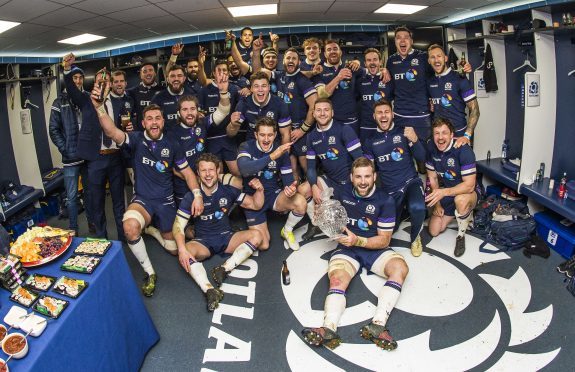Basking in the glowing reviews for their autumn campaign, Scotland’s players return to their clubs and the coaches to their laptops for the next two months.
Despite November’s successes, there’s still plenty to do. Here’s a few of the most pressing issues for Scotland as the most anticipated Six Nations in years approaches.
Some variety to sheer speed
One setback to other nations taking you seriously at last – they’ll take you very seriously.
Scotland played a different type of game this autumn, like the All Blacks but if anything at an even faster tempo. Townsend believes with recent law changes giving advantages to the attacking team that this is where the game’s future lies, and you’d have to hope so because it’s bloody entertaining to watch.
But there are more conservative and equally as savvy coaches out there. Joe Schmidt in Ireland has built his excellent team on power and kicking, plus a wee bit of guile wrapped up in a powerful package in the newcomer Jacob Stockdale. Schmidt will believe his side can stop Scotland’s “chaos” game.
Similarly Warren Gatland might hint at a more open style playing two stand-offs but you suspect that after a tepid autumn he’ll revert to the point-to-point game that has served his teams so well in successive Six Nations in his long tenure in Wales.
And Eddie Jones will believe that the traditional English values of a monster pack, the ball control of Owen Farrell and his outstanding “finishers” can subdue Scotland, as they have done for much of the last two decades.
Scotland aren’t all flash, of course; the driving mauls, not a traditional Scottish weapon, were hugely effective against Samoa and Australia.
Townsend won’t have shown half of his hand because he knows how closely others are watching. But everyone will have studied the Scottish style and have ideas to stop it.
The problem with Greig
Scotland have a succession problem. The Autumn Tests illustrated that John Barclay is outstanding captain, Finn Russell a more than decent goalkicker and Ali Price generates the kind of pace from scrum-half that is crucial to the high tempo game the Scots want to play.
So where does Greig Laidlaw, the cornerstone of the team during their rise from mediocrity, fit into this? Against Ireland in the Six Nations opener in the spring, his leadership and kicking qualities were supremely evident.
But he got injured in the next game, and then again prior to the Autumn Tests, having gone with the Lions to New Zealand when he was set to reassume the captaincy of Scotland on their summer tour.
And during his absences Price, who has been nurtured carefully by Mike Blair at Glasgow, has become a key man.
Laidlaw was with the squad during the autumn helping with squad leadership matters in camp. He has great value in this; he’ll certainly be a coach when he finishes playing. But he hasn’t finished yet and there’s an awkward situation developing.
Laidlaw is passionate about playing for Scotland and being captain. But times may have moved on.
Richie Gray
Of all the missing men (who were not missed that much) this autumn it’s arguably a fully-fit Richie Gray who would do most to improve Scotland. Ben Toolis and Grant Gilchrist did well in his slot over the last six tests, but Gray has real pace as a ball carrier, and is a threat on opposition lineout ball at almost every throw.
Furthermore, in last year’s Six Nations he was possibly Scotland’s best tight forward over the four games he played, even carrying the back problem that required surgery at the end of the season.
He still hasn’t played since, but has started training again with his club Toulouse.
Whether the Six Nations is too soon is a question, but a fresh Richie towards the end of the championship would be a significant asset. If he recovers well, expect the Gray Bros second row combination to be resumed.
The scrum
The one area that Scotland clearly struggled this autumn was the scrummage, failing to pressurize Samoa, struggling against an inexperienced All Black front row, and only turning the screw on Australia once Sepoke Kepu was sent off.
The Scots were down an astonishing five and half front-line props (the half was Zander Fagerson being saved for the bench against Australia). But they muddled through, much as they did the previous season with Allan Dell and Fagerson as international novices.
However while Stuart McInally and Fraser Brown might have finally squeezed out Ross Ford at hooker, and as well as Darryl Marfo and Jamie Bhatti did, you’d have a full functioning Alasdair Dickinson and WP Nel in there to give Scotland a dominant scrum like they had in 2015/16. Dickinson’s continuing absence doesn’t suggest he’ll be up to speed in time for the Six Nations, while Gordon Reid’s availability remains in doubt.
It needs Dell and Rory Sutherland to step forward to give options; Dell’s scrummage work has improved and he’s the best about the park of all the contenders.
Defensive consistency
Scotland are polar opposites in defence sometimes week to week.
Against England in the spring they were opened up almost at will and all too easily. The following week they “nilled” Italy. Against Australia in Sydney in June there was a monumental defensive display, the next week in Fiji they looked listless and underprepared.
This autumn against Samoa Scotland surrendered five tries, then held the All Blacks to three points in the first 40 minutes the following week. Then they looked a little passive at times in defence against the Wallabies.
Changing personnel didn’t help on occasion, but if Scotland are a machine with interchangeable parts (as they seemed to be going forward) it’s essential they find a more consistent mark in defence. Preferably it’s the All Black performance, but it has to be something much better than we’ve seen in four of the last seven games.
Wales is the only game that matters right now
Everyone – as usual – is wound up at the thought of the Calcutta Cup game, even more so this year because there’s a score to settle after the “blip” of Twickenham last year.
But it’s not until Round 3. Scotland start in Cardiff where they haven’t won since 2002, when Townsend was playing, and Scott Murray had Wales in fits at the lineout.
Wales have looked a little staid at times this autumn. There are so many Lions in their squad and a gruelling 2017 may be catching up with them.
But there’s a quality spine to the team and while they plan to shoot themselves in the foot by not picking Rhys Webb, it won’t be until next season.
If Scotland are for real, they have to win in Cardiff. The Calcutta Cup game won’t have half the value and excitement if the Scots don’t beat Wales and France first.


